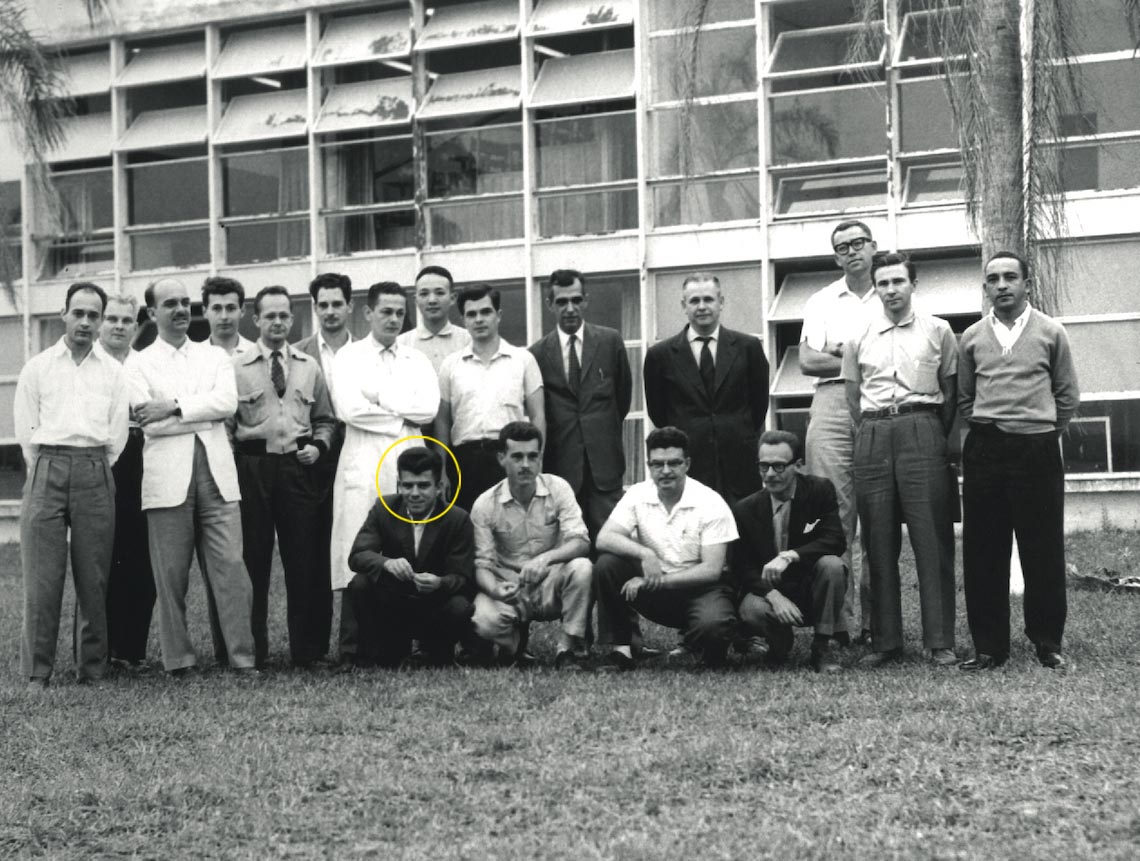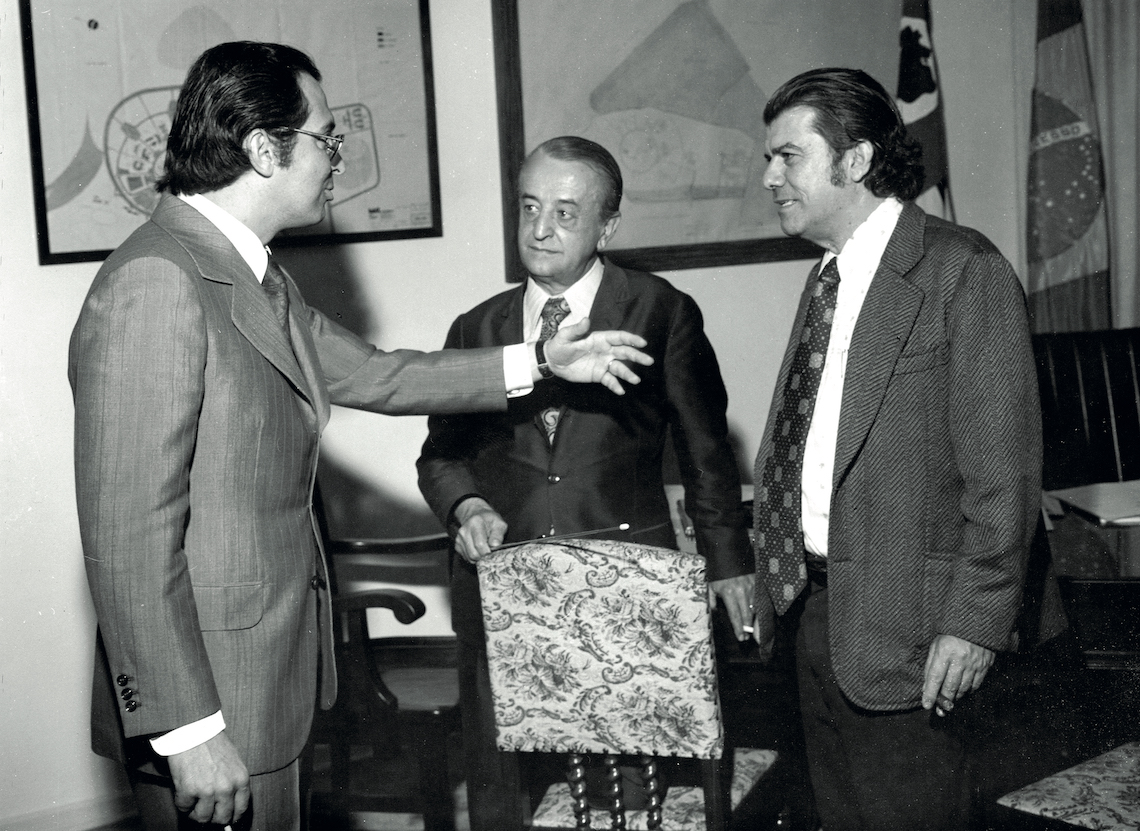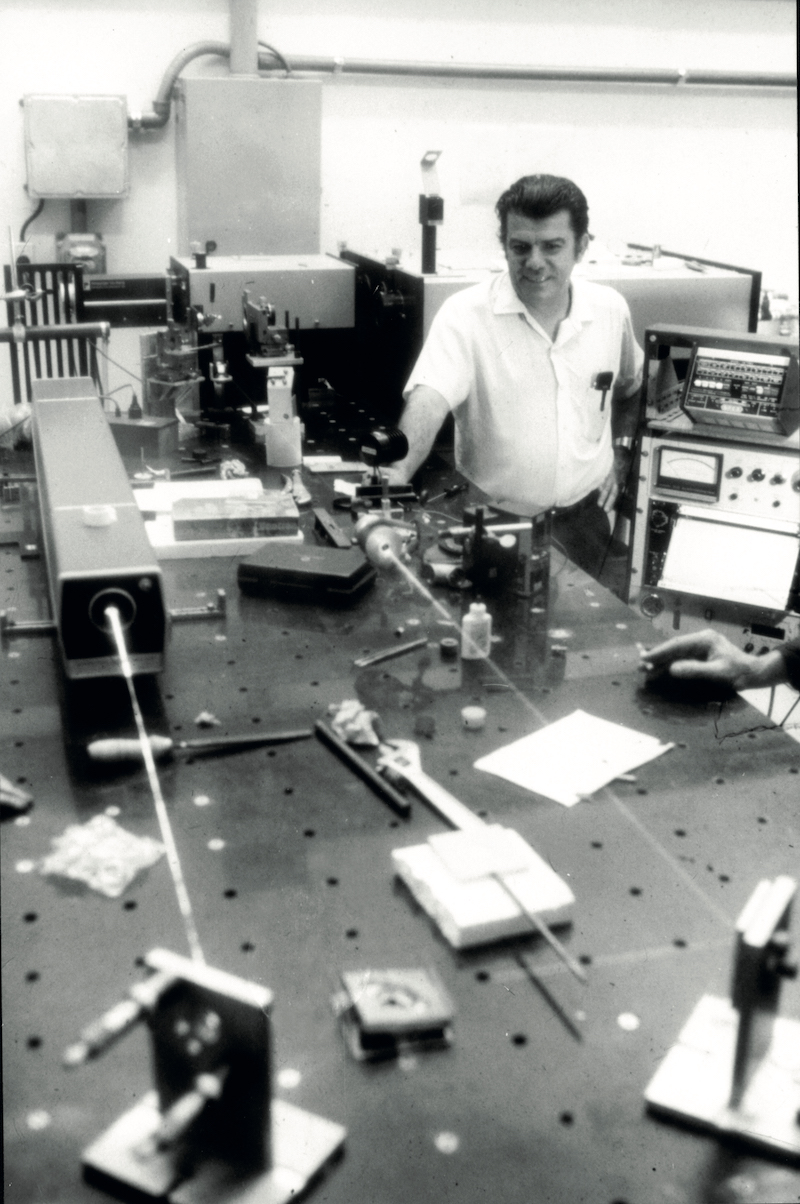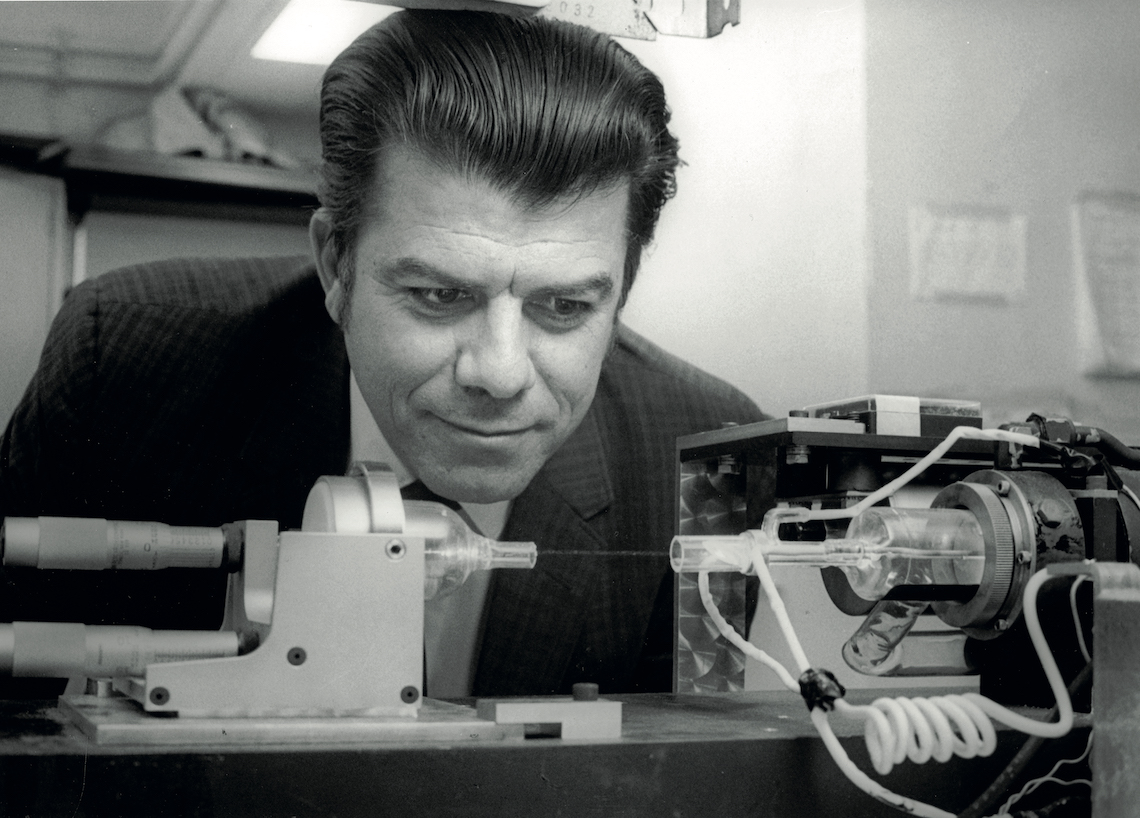Back in the 1950s, fairly little was known about laser technology in Brazil—or anywhere else for that matter. The ability to use radiation to produce light particles concentrated in a continuous beam was a thing seen only in science-fiction films and series. Few scientists understood at that time the many research possibilities and applications that laser light could offer. One of those few was Brazilian physicist Sérgio Porto, who died now 40 years ago. He is credited by physicists and historians of science for progress made in global research on laser technology, and for introducing the technology in Brazil and developing applications in several fields besides physics.
Sérgio Pereira da Silva Porto (1926–1979) was born in Niterói, Rio de Janeiro, the son of a fisherman. He earned a degree in chemical engineering at age 20, at the former National School of Philosophy (FNFi) at the University of Brazil, now the Federal University of Rio de Janeiro. He moved to the US soon after graduating to pursue a doctoral degree in physics at Johns Hopkins University in Baltimore. After returning to Brazil in 1954, he began a career as a professor of statistical mechanics in the Department of Physics at the Brazilian Air Force Institute of Technology (ITA), in São José dos Campos, southeastern Brazil.
It was there that in mid-1959, the Brazilian physicist first came in contact with the theoretical foundations of laser technology through an article published in Physical Review by physicists Arthur Schawlow (1921–1999) and Charles Townes (1915–2015) at Bell Labs—a company in New Jersey with a strong tradition in technology-oriented basic research. “Porto was excited about the new insights into light that were emerging and began lecturing on the subject at ITA,” says physicist and historian of science Olival Freire Junior, a professor at the Institute of Physics and associate dean for research at the Federal University of Bahia (UFBA). “His reading of that article would open several windows of opportunity throughout his career, and his capitalizing on those opportunities would redefine his scientific trajectory.”

ITA library archive
Porto (circled) and fellow ITA professors in the early 1960sITA library archivePorto’s passion for laser technology led to a visit from a group of researchers from Bell Labs to lecture at ITA. “During the visit, he was invited back to the US to work with Townes and Schawlow,” says Freire. Townes would later win the 1964 Nobel Prize in Physics for his contributions in the field of quantum electronics, which led to the construction of oscillators and amplifiers based on the maser-laser principle. Schawlow, too, would win a Nobel Prize in Physics in 1981 for his contributions to the development of high-resolution laser spectroscopy.
Freire and historian of science Walker Lins de Santana, of UFBA, discuss part of Porto’s work and his contributions to the introduction of laser technology in Brazil in an article published in the journal Revista Brasileira de Ensino de Física (Brazilian journal of physics teaching). Freire explains that scientific institutions and universities in Brazil had at that time fallen into disrepair, leading Porto to accept the invitation to work at Bell Labs.
Going to the US put Porto in the right place, at just the right time—laser research would begin to attract global interest in the early 1960s. What is more, the Brazilian physicist had the opportunity to work and interact with some of the most prominent researchers in the field, many of whom would go on to win Nobel Prizes in Physics for their contributions to laser research, including such names as Nicolaas Bloembergen (1920–2017) and Aleksandr Mikhailovich Prokhorov (1916–2002).

Nokia Bell Labs
Porto in his laboratory at Bell Labs in 1966, using a laser beam to produce Raman scatteringNokia Bell LabsPhysicist Ado Jorio, a professor in the Department of Physics and associate dean for research at the Federal University of Minas Gerais (UFMG), notes that it was at Bell Labs that Sérgio Porto pursued his most important lines of research, and it was there that his research was most productive. Porto’s contributions primarily involved the use of the Raman effect or Raman scattering—a phenomenon first observed experimentally in 1928 by Indian-born physicist Chandrasekhara Venkata Raman (1888–1970), who won the 1930 Nobel Prize in Physics—to derive information about the molecular structure of materials.
Raman scattering occurs when light particles (photons) collide with the molecules of gases, liquids, or solids. Its use in analyzing the properties of materials was limited by the difficulty in creating a strong, monochromatic light source. Porto saw the potential that emerging laser technology had to fill this gap. “By applying laser radiation to produce the Raman effect, he was able to produce higher-resolution light scattering than was previously possible,” says Jorio. “This made it possible to use Raman scattering spectroscopy to obtain chemical and structural information on virtually any material, meaning that materials could be identified in a matter of seconds.”
Porto’s work was published in 1962 in the Journal of the Optical Society America and attracted much interest from the international scientific community. “Porto’s laboratory at Bell Labs became one of the most important research centers in the field of solid-state spectroscopy,” says Jorio. His prestige soon earned him a position as research manager. “He availed himself of his position to recruit young Brazilian physicists, such as Rogério Cezar de Cerqueira Leite and José Ellis Ripper Filho, to work at Bell Labs,” says Santana, who has researched the history of laser technology in Brazil and Porto’s contributions since defending his thesis in 2006 in a graduate program in education, philosophy, and history of science at UFBA.

Central archive / SIARQ / Unicamp
Porto (right), Zeferino Vaz (center) and Carlos Antonio Rocca, the São Paulo State Secretary of Finance, in 1974Central archive / SIARQ / UnicampTraining new physicists
Years later, in 1967, Porto was offered tenure as a professor of physics and electrical engineering at the University of Southern California, Los Angeles. “He accepted the invitation and, as he had done at Bell Labs, he made USC a venue for training Brazilian physicists.” This, explains Jorio, led to the creation of several solid-state physics centers in Brazil, largely revolving around Raman scattering spectroscopy. “Porto had a passion for mentoring students he thought had potential,” says electronic engineer José Ellis Ripper Filho, who studied under the Brazilian physicist in the late 1950s when pursuing his undergraduate degree at ITA. “It was the same with me,” he says. “He went lengths to mentor and support me in developing my career.”
The time he spent in the US helped to elevate Porto to a position of international prestige as a leading figure in the multiple applications of laser technology. “Yet he was prepared to return to Brazil provided he could work at a research institution offering the same working conditions as he was afforded in the US,” says Freire.
The political and economic context that paved the way for his return began to take shape in 1968 under the military presidency of Artur da Costa e Silva (1967–1969). That period saw significant government investment in areas considered strategic, and the Federal Government was keen to bring him back to Brazil after learning about the laser isotope uranium enrichment program he was developing, explain Freire and Santana. “João Paulo dos Reis Velloso [1931–2019], then Minister of Planning, was tasked with the negotiations between the Brazilian government and Porto,” says Freire. The physicist demanded adequate laboratory facilities, 30 PhDs as staff, and US$2 million in funding as a condition of returning. However, negotiations with the University of Brasília (UnB) and the University of São Paulo (USP) were unsuccessful.

Central archive / SIARQ / Unicamp
Porto at work at the UNICAMP Institute of Physics in the 1970sCentral archive / SIARQ / UnicampThe then newly created University of Campinas (UNICAMP), under the deanship of Zeferino Vaz (1908–1981), was the only university prepared to meet his terms. The plan was to make UNICAMP the Brazilian equivalent of Bell Labs. Porto transferred to UNICAMP in 1972, devoting his time there to research and training researchers through programs related to laser technology and its applications. These led to the creation of the Gleb Wataghin Institute of Physics (IFGW) in 1974. Many students were attracted to attend UNICAMP because of Porto’s research and the intellectual environment he had created there. Among them was physicist Carlos Henrique de Brito Cruz, now scientific director at FAPESP, who would later serve as dean of the university between 2002 and 2005. He went to UNICAMP to do his doctorate and work with Porto in early 1979, six months before the physicist’s death.
Porto and his team also contributed to the advancement of many fields beyond condensed matter physics, including chemistry, engineering, and especially medicine, in which laser technology was introduced as a surgical tool in areas such as dentistry, otorhinolaryngology, gynecology, and cardiology. A practical example of his research was the development of arterial angioplasty techniques utilizing laser beams to vaporize atheromatous plaques.
Sergio Porto died in June 1979 in Novosibirsk, in the former Soviet Union, at the age of 53. He had a massive heart attack during a soccer match with researchers of different nationalities who were attending a laser physics conference. Porto died at the height of his intellectual powers and left a valuable scientific legacy to the field of physics in Brazil, Olival Freire concludes.
Republish

